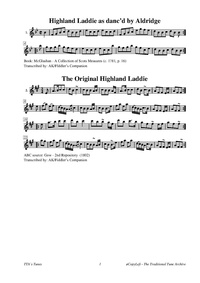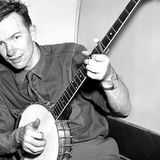Template:Pagina principale/Vetrina: Difference between revisions
No edit summary |
No edit summary |
||
| Line 1: | Line 1: | ||
{{SheetMusic | {{SheetMusic | ||
|f_track= | |f_track=Bonnie Laddie Higland Laddie.mp3 | ||
|f_pdf= | |f_pdf=Highland Laddie.pdf | ||
|f_artwork= | |f_artwork=Pete Seeger Banjo.jpg | ||
|f_tune_name= | |f_tune_name=Highland Laddie | ||
|f_track_title= | |f_track_title=Highland_Laddie_(1) | ||
|f_section=abc | |f_section=abc | ||
|f_played_by=[https://soundcloud.com/ | |f_played_by=[https://soundcloud.com/pete-seeger-official Pete Seeger] | ||
|f_notes= | |f_notes= Way hay & away we go, Bonnie Laddie, Hieland Laddie. | ||
|f_caption= | |f_caption=A version of the melody appears in the Drummond Castle Manuscript (in the possession of the Earl of Ancaster at Drummond Castle), inscribed "A Collection of Country Dances written for the use of his Grace the Duke of Perth by Dav. Young, 1734. | ||
|f_source=[https://soundcloud.com/ | |f_source=[https://soundcloud.com/pete-seeger-official/bonnie-laddie-higland-laddie Soundcloud] | ||
|f_pix=420 | |f_pix=420 | ||
|f_picpix=200 | |f_picpix=200 | ||
|f_article=[[ | |f_article=[[Highland_Laddie_(1) | '''Highland Laddie''']] | ||
Mention of the tune appears in the '''Gentleman's Magazine''' for 1750 that "The Highland Laddie written long since by Allan Ramsay, and now sung at Ranelagh and all the other gardens; often fondly encor'd, and sometimes ridiculously hiss'd," for, as Emmerson (1971) points out, the rising of 1745 of Bonnie Prince Charlie was fresh in the minds of many at the time. | |||
However, by the end of the century that memory had dimmed to the extent that Gow noted in his '''Repository''' (Part Second, 1802) "The Quick step (sic) of the gallant 42nd Regiment (The Royal Highlanders, or, more popularly, The Black Watch). It was performed when the Regiment was reviewed by His Majesty at Ashford, May 7, 1802. | |||
David Murray ('''Music of the Scottish Regiments''', Edinburgh, 1994, p. 178) writes: "A journalist at the 1845 Queen's Birthday Parade commented that the Scots Guards marched past to 'The national, but mediocre melody 'Will ye go to Inverness?'-there are several versions of the song-and he compared it unfavorably with the splendid music played by the Coldstream Guards. | |||
The same, it must be said, holds good today. Consisting as it does of two simple eight-bar phrases, each repeated, 'Highland Laddie' can become monotonous when, for instance, a battalion in column or route has to be played past." Still, it has the ability to stir: a piper led the British invasion of Normandy's Sword beach playing the "Highland Laddie." | |||
'' | It is still played on ceremonial occasions. In the 19th century "Highland Laddie" was the march-past in quarter-column of all the Highland regiments in the British army<ref>Walter Wood, "The Romance of Regimental Marches", '''Pall Mall Magazine, vol. 9''', 1898, pp. 421-430.</ref>. | ||
}} | }} | ||
Revision as of 12:17, 12 November 2023

Played by: Pete Seeger
Source: Soundcloud
Image: Way hay & away we go, Bonnie Laddie, Hieland Laddie.

Mention of the tune appears in the Gentleman's Magazine for 1750 that "The Highland Laddie written long since by Allan Ramsay, and now sung at Ranelagh and all the other gardens; often fondly encor'd, and sometimes ridiculously hiss'd," for, as Emmerson (1971) points out, the rising of 1745 of Bonnie Prince Charlie was fresh in the minds of many at the time.
However, by the end of the century that memory had dimmed to the extent that Gow noted in his Repository (Part Second, 1802) "The Quick step (sic) of the gallant 42nd Regiment (The Royal Highlanders, or, more popularly, The Black Watch). It was performed when the Regiment was reviewed by His Majesty at Ashford, May 7, 1802.
David Murray (Music of the Scottish Regiments, Edinburgh, 1994, p. 178) writes: "A journalist at the 1845 Queen's Birthday Parade commented that the Scots Guards marched past to 'The national, but mediocre melody 'Will ye go to Inverness?'-there are several versions of the song-and he compared it unfavorably with the splendid music played by the Coldstream Guards.
The same, it must be said, holds good today. Consisting as it does of two simple eight-bar phrases, each repeated, 'Highland Laddie' can become monotonous when, for instance, a battalion in column or route has to be played past." Still, it has the ability to stir: a piper led the British invasion of Normandy's Sword beach playing the "Highland Laddie."
It is still played on ceremonial occasions. In the 19th century "Highland Laddie" was the march-past in quarter-column of all the Highland regiments in the British army[1].
...more at: Highland Laddie - full Score(s) and Annotations
X:1 T:Highland Laddie as danc'd by Aldridge M:C| L:1/8 B:McGlashan - A Collection of Scots Measures (c. 1781, p. 16) Z:AK/FIddler's Companion K:Bb V:1 clef=treble name="1." [V:1] B2|FGBc dBBd|eccd eccd|FGBc egfe|dBBc dB B:| |:b|gfgb gfed|eccd eccb|gfgb gfce|dBBc dBB:|]
- ↑ Walter Wood, "The Romance of Regimental Marches", Pall Mall Magazine, vol. 9, 1898, pp. 421-430.
